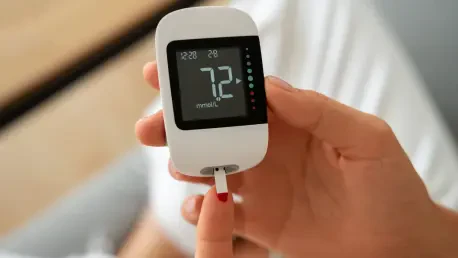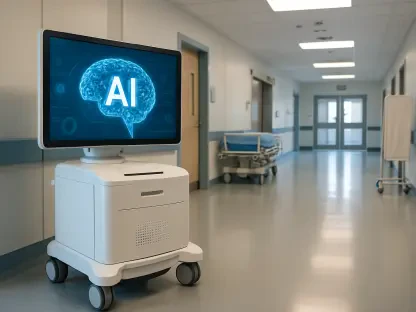In an era where chronic health conditions are on the rise, the glucose monitoring devices market is emerging as a critical segment of healthcare technology, driven by the escalating global diabetes epidemic. With over 530 million adults currently living with diabetes—a figure projected to climb to 640 million by 2030—the demand for innovative tools to manage blood sugar levels has never been more urgent. This market encompasses a broad spectrum of solutions, from traditional self-monitoring blood glucose (SMBG) devices to cutting-edge continuous glucose monitoring (CGM) systems and promising noninvasive technologies. These advancements are not just improving patient outcomes but are also reshaping how diabetes care is delivered worldwide. As technological innovation accelerates and health awareness grows, this sector is poised for remarkable expansion, offering both challenges and opportunities for stakeholders. This article explores the key drivers, regional trends, and future prospects fueling this robust growth in diabetes management solutions.
Escalating Diabetes Burden Fuels Market Expansion
The global surge in diabetes prevalence stands as the cornerstone of growth for the glucose monitoring devices market, reflecting a pressing public health challenge. Factors such as urbanization, sedentary lifestyles, and unhealthy dietary patterns are contributing to this epidemic, particularly in low- and middle-income nations where access to healthcare can be limited. As the number of affected individuals continues to rise, the need for reliable devices that cater to both personal and clinical use becomes paramount. These tools are essential for ensuring accurate blood sugar readings and supporting effective glycemic control, which can prevent severe complications. Manufacturers are under increasing pressure to develop solutions that meet diverse patient needs, from affordability to ease of use, while addressing the sheer volume of demand across different demographics and geographies.
Beyond mere numbers, the societal and economic implications of diabetes are profound, pushing healthcare systems to prioritize early detection and management strategies. Governments and organizations worldwide are stepping up with awareness campaigns that educate populations on the importance of monitoring blood glucose levels regularly. In developed regions, supportive policies often include subsidies or reimbursement for advanced devices, making them accessible to a broader audience. Meanwhile, emerging economies are witnessing a gradual shift as rising healthcare expenditures enable greater penetration of these technologies. This dual momentum underscores the market’s expansion, highlighting a shared global commitment to tackling diabetes through innovative monitoring solutions that empower patients to lead healthier lives.
Technological Advancements Redefine Diabetes Care
Technological innovation is fundamentally transforming the landscape of glucose monitoring, moving far beyond the traditional finger-prick methods that once dominated the field. Continuous glucose monitoring (CGM) systems have become a game-changer, offering real-time data with minimal discomfort and allowing patients to track trends in their blood sugar levels effortlessly. These devices, often integrated with mobile applications and wearable technologies like smartwatches, provide a seamless user experience that aligns with modern digital lifestyles. The shift toward such advanced solutions not only enhances patient compliance but also enables more informed decision-making regarding diet, exercise, and medication, ultimately improving health outcomes across diverse populations.
Looking ahead, the advent of noninvasive glucose monitoring technologies marks a pivotal moment in this market’s evolution, promising to eliminate the pain associated with frequent testing. Innovations in optical sensing and nanotechnology are paving the way for devices that can measure blood sugar levels through the skin, a development long anticipated by patients and clinicians alike. Additionally, the integration of artificial intelligence (AI) and data analytics into these systems is set to revolutionize diabetes management further. Predictive models can now anticipate glucose fluctuations, offering personalized insights and proactive interventions. As digital health continues to gain traction, the convergence of biosensors and wearable tech is empowering individuals to take greater control over their condition, setting a new standard for chronic disease care.
Regional Dynamics and Emerging Opportunities
Geographically, the glucose monitoring devices market exhibits distinct patterns, with North America currently holding the lead due to its high diabetes prevalence and advanced healthcare infrastructure. The United States stands out as a hub of innovation, frequently introducing new products and conducting clinical trials to explore next-generation solutions like noninvasive monitoring. A strong regulatory framework and reimbursement policies in this region facilitate the rapid adoption of cutting-edge technologies, ensuring that patients have access to the latest tools for managing their condition. This dominance reflects a broader trend of prioritizing chronic disease management within well-resourced healthcare systems that can support widespread implementation.
In contrast, the Asia-Pacific region is emerging as the fastest-growing market, driven by a burgeoning diabetic population in countries such as India and China, where healthcare needs are escalating rapidly. Rising investments in medical infrastructure, coupled with growing public awareness about diabetes management, are creating fertile ground for affordable and accessible monitoring solutions. Europe, meanwhile, maintains a strong position with its robust healthcare systems and regulatory environment that accelerates the approval and commercialization of new devices. These regional disparities highlight the importance of tailored strategies to address unique challenges, from economic constraints to cultural attitudes toward health technology, while capitalizing on untapped potential in developing markets.
Future Horizons in Glucose Monitoring
As the glucose monitoring devices market looks to the future, a significant transformation is anticipated through the continued embrace of digitalization within healthcare systems globally. The integration of AI-driven predictive analytics and real-time data processing is poised to redefine diabetes care by enabling highly personalized treatment plans. Such advancements allow for early interventions that can prevent dangerous glucose spikes or drops, enhancing patient safety and quality of life. With healthcare increasingly shifting toward in-home care models, the demand for intuitive, user-friendly devices that seamlessly blend into daily routines is expected to grow, supported by ongoing investments in research and development focused on continuous and noninvasive monitoring technologies.
Reflecting on the trajectory of this market, it’s evident that past efforts in innovation and policy support have laid a solid foundation for what lies ahead. The strides made in CGM systems and the early successes of noninvasive solutions were critical in addressing patient pain points and improving adherence to monitoring regimens. Collaborations between technology firms and healthcare providers proved instrumental in driving these advancements, while regional initiatives helped bridge access gaps. Moving forward, stakeholders should focus on scaling affordable solutions for emerging markets, leveraging digital tools for broader reach, and fostering partnerships to accelerate innovation. These steps will ensure that the momentum built over recent years continues to transform diabetes management for millions worldwide.









